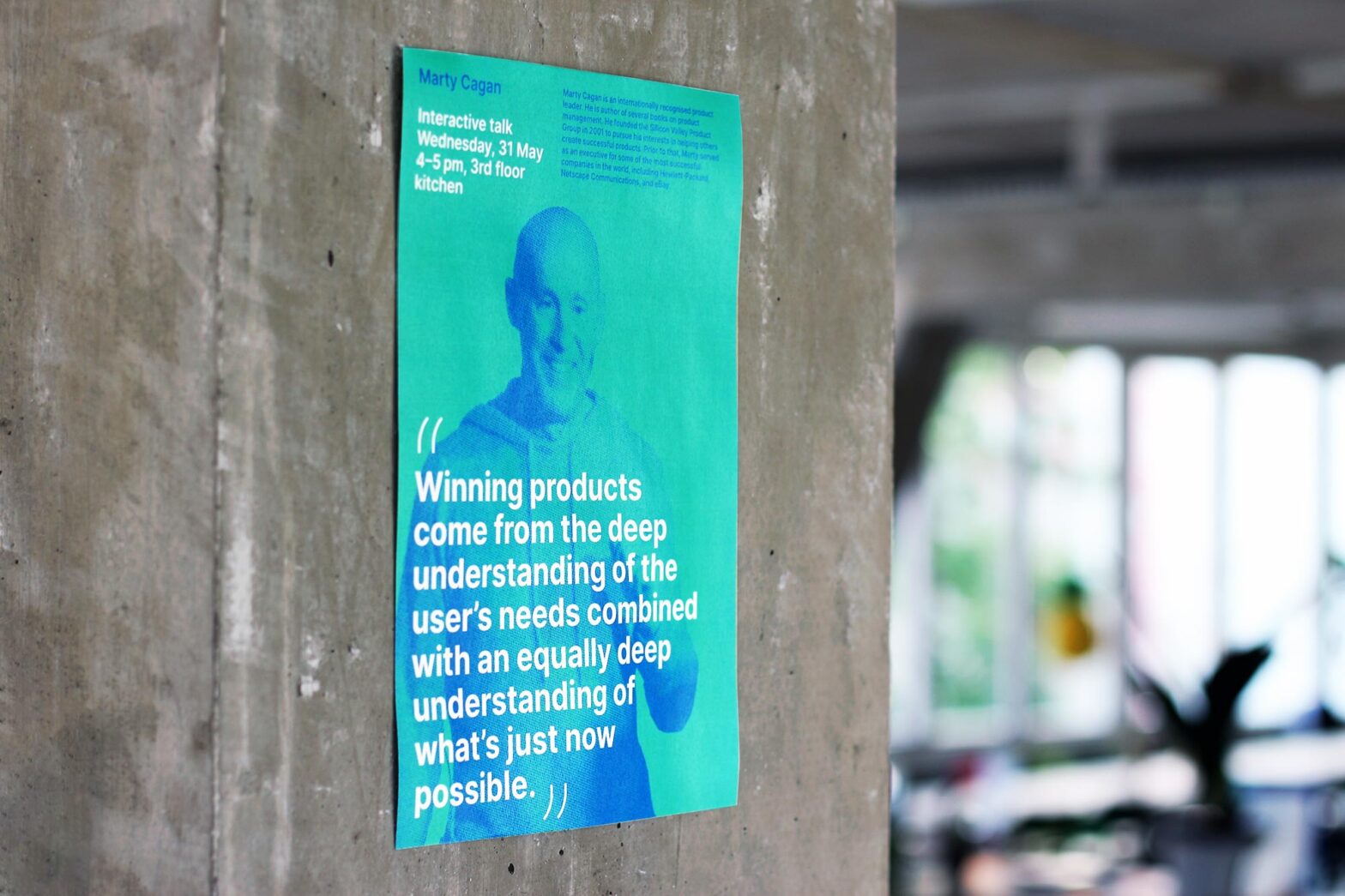Posters are up, people read the pre-read, and a few questions are collected. Next week, we have an admired guest speaker joining us for an hour. Marty Cagan, co-founder of Silicon Valley Product Group, public speaker and serial book author, will talk about his experience building products, the organisations behind and their culture.
The mini poster for the office space is inspired by my former colleague Laurence’s Swiss grid events posters from a few years ago. They were just too lovely to be ignored. So, I told him, and he said some of Facebook’s internal posters inspired them. So, we are all building on each others’ work.
It’s vital for us at Digital Service to stay in sync with the private sector and academia, not only other public sector organisations around the globe. It matters on an organisational level but equally on a personal level – to be inspired and engaged while some work we do might be slow and arduous.
Progressing community work
At the end of this week, I reached a little milestone: Maria, a service designer at the German Pension Insurance, and I completed our proposal and operational outline for a new community of practice on user-centred design. This work had stagnated for some months for multiple reasons, but having Maria join me unblocked it. She helped carry it to the finishing line. In the coming weeks, we hope to start the community as part of the NExT network’s existing community framework. Their suggested timeframe is about 6 weeks from submission to launch.
Throughout the week, I had several conversations with people from other public sector organisations about how we do user-centred design things, touching on accessibility user research operations and shared design components. Lots of these conversations could be much more channelled with established cross-organisational communication channels that don’t rely on email and some shared knowledge base.
Next week, we have an exchange with other user researchers from public sector organisations, including the state-government IT supplier Dataport and the Federal Printing Office. I hope some joint efforts grow from this initial conversation. Ideally, they should be tied into the future NExT community.
In our small user research channel, we also discussed the position of Joe Tomlinson, Professor of Public Law at the University of York, who argued for government to publish most of its user research for the public good. There would be various benefits, and, of course, it would align with our ‘open by default’ approach. However, given the additional work, it would have to be argued and agreed upon with budget holders early. It cannot be a mid-project afterthought.
Agreed with everyone involved and advertised in the Creative Bureaucracy Festival newsletter, our next local meetup is live. The first set of 50 spots was claimed within 3 hours. We have some, but not all, speakers confirmed. With many international colleagues coming to Berlin for Creative Bureaucracy Festival, we will hear in several short talks about the digital transformation work underway in Cyprus, Estonia, France, Iraq, and the United Kingdom.
Our fish bowl panel discussion on the 15th of June is also coming together. Estonia, France, Italy, and the UK will participate – with a healthy gender balance. I am hoping to update the panel description shortly to reflect our participants.
Putting emphasis on standards
Our standard-related blog posts and self-reports still need to be published, but we have progressed with our comms colleagues. I conversed with people who expressed gratitude for having the Service Standard referenced in contractual agreements with stakeholders. But what we often see is that one group of people is negotiating such reference documents, and another group is working with the digital service teams afterwards. They might have a different understanding or even be aware of agile ways of working, user-centred approaches or the Service Standard. So, it’s our duty and a necessity to educate every colleague and stakeholder about them.
This week, the bill for the updated online access law was published. While standards are mentioned in a general sense, the Service Standard specifically is not called out. More broadly, the draft lacks the awareness that government is a service provider at large. Applying and speaking about the Service Standard bottom-up remains imperative.
With surprise and awe, I discovered the documentation that the UK’s Department for Education published on applying the Service Standard in their ministry. On less than 20 pages and one for each point, it describes who each point is most relevant for and what to do in each development phase. You can see from the description that teams have followed the standard, and their experience is reflected in the documentation.
In some not-so-far future, I want us to create similar documentation that extends the existing guidance of the Ministry of Interior on the Service Standard. Such should be co-created with colleagues from other public sector organisations.
What’s next
Next week is going to be busy. With a public holiday on Monday, the week will be shorter.
We will work on the objectives for the coming 3 months, which we started discussing among the heads of delivery disciplines earlier this week.
Katrin and I are finishing the Service Gazette for Creative Bureaucracy Festival. The issue should get to the printer by the end of the week.
On Tuesday, we will have some farewells to long-serving colleagues. For them, we created some personal and hopefully moving parting gifts.
On Friday, I have a cross-government brand strategy workshop that I’m very much looking forward to.

